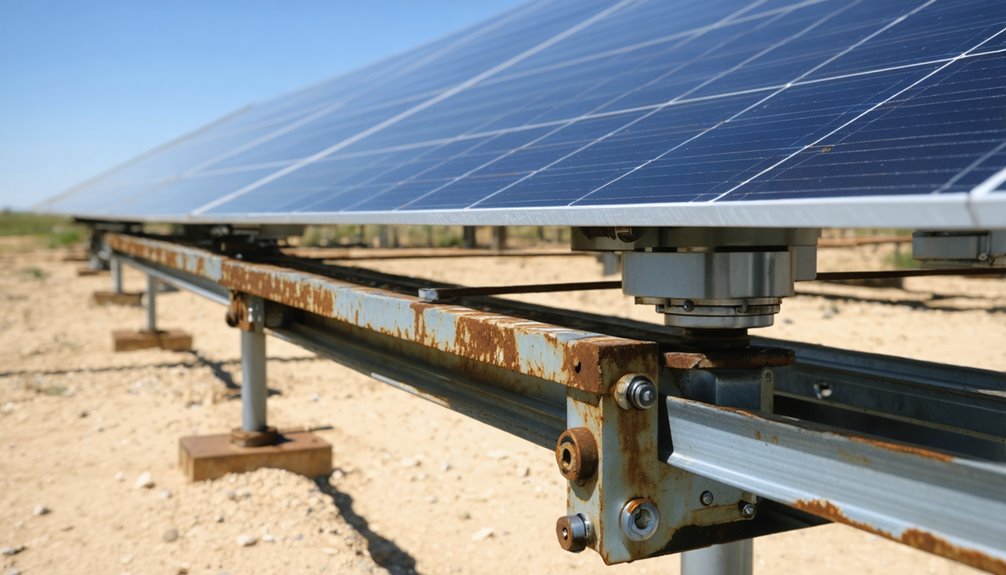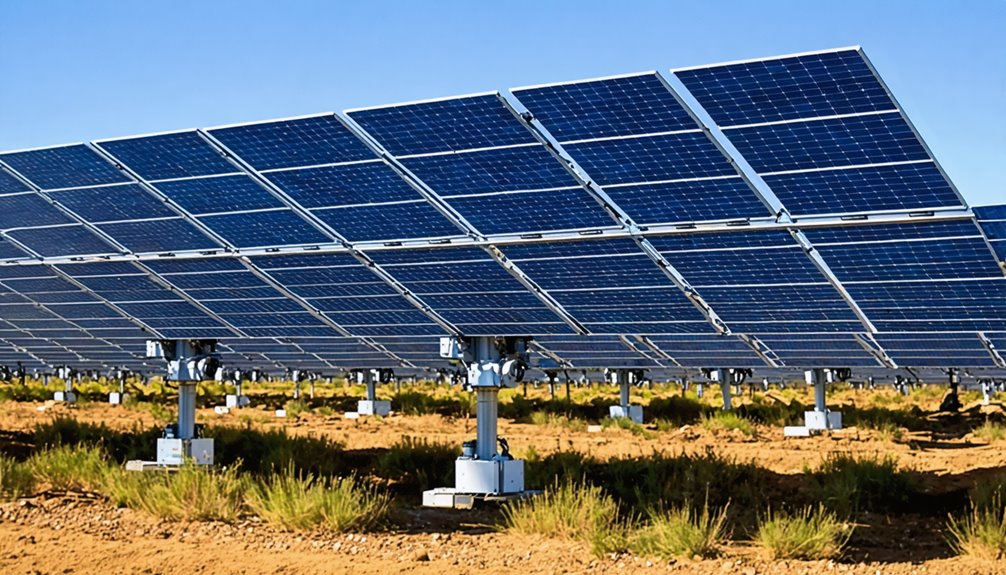You’ve probably seen solar panels sitting still on rooftops, but what if they could move? Solar panel tracking mount systems follow the sun’s path across the sky. They’re like mechanical sunflowers that rotate throughout the day. These systems can boost energy production by up to 45% compared to fixed panels. But how do they actually work,
How Solar Panel Tracking Mount Systems Work
When you watch a sunflower turn its head to follow the sun across the sky, you’re seeing the same principle that solar panel tracking mount systems use. These tracking systems work by using motors and sensors to move solar panels throughout the day. The sensors detect the sun’s position and send signals to the motors. The motors then adjust the panels’ angle to face the sun directly.
There are two main types: single-axis and dual-axis trackers. Single-axis systems rotate east to west. Dual-axis trackers move in two directions – they can tilt north to south and rotate east to west. This constant adjustment means the solar panels capture more sunlight than fixed panels. The result? Your energy output increases by 25% to 45%. Unlike fixed pole mount systems, tracking mounts require more complex mechanical components but deliver superior energy production through their dynamic positioning capabilities.
Types of Solar Panel Tracking Mount Systems
Several different types of solar panel tracking mount systems can boost your solar energy production. You’ll find three main categories: active, passive, and manual systems.
Active solar trackers use motors and sensors to follow the sun’s path. They’re the most efficient option
Single-Axis vs. Dual-Axis Tracking Systems
Once you’ve decided on an active tracking system, you’ll need to choose between single-axis and dual-axis models. Single-axis tracking systems rotate panels from east to west throughout the day. These solar trackers boost energy production by 25% to 35% compared to fixed panels. They’re popular for large solar farms because they don’t need much space.
Dual-axis tracking systems move in two directions. They adjust both north-south and east-west angles for ideal sunlight exposure. This technology increases energy output by 30% to 45% over fixed systems. These trackers sit on single posts, creating space underneath for farming or parking. While they produce more power, they’re more complex than single-axis models. Both types use motors and sensors to follow the sun’s path automatically.
Active Solar Tracking Technology and Components
Active solar tracking systems use advanced technology to follow the sun’s path across the sky. These active trackers rely on motors and sensors to move panels throughout the day. They’ll automatically adjust positions to capture maximum sunlight.
The technology includes hydraulic actuators that convert fluid pressure into precise movements. A dual-axis tracking system can boost energy output by up to 45% compared to fixed panels. That’s a significant increase in power generation.
However, you’ll find these solar tracking systems need regular maintenance. The mechanical parts can break down more often than static installations. Most active trackers work best with ground-mounted setups. They’re more complex to install and require careful planning before setup begins. Unlike fixed ground installations, tracking systems demand specialized structural engineering to support the additional weight and movement of motorized components.
Passive Solar Tracking Mechanisms
Two main types of solar tracking exist, and passive systems work without any motors or power sources. These passive solar tracking mechanisms use thermal expansion to operate. When sunlight heats a special liquid, it evaporates and expands. This expansion causes the panels to tilt and adjust toward the sun naturally.
You’ll find these systems need minimal maintenance because they have fewer moving parts than active trackers. They’re perfect for remote locations where regular service isn’t practical. The materials in these trackers respond directly to sunlight throughout the day.
While passive trackers don’t match active systems’ performance, they still provide decent energy gain. You can expect efficiency improvements between 15% and 25%. They’re an economical choice when you don’t need precise positioning.
Cost Analysis of Solar Tracking Mount Systems
You’ll pay much more for solar tracking systems than fixed panels, with single-axis trackers adding about 57% to your project’s cost. A typical 4-kilowatt ground system costs around $13,000, but adding a single-axis tracker pushes that to $20,000, while dual-axis systems can reach $26,000. The extra investment might pay off since trackers can boost your energy production by 25% to 45%, though you’ll also face higher maintenance costs from the moving parts.
Initial Investment Costs
Three main factors drive up the initial costs of solar tracking mount systems compared to standard installations. First, you’ll see the equipment itself costs $500 to over $1,000 per panel. Second, your installation costs jump because these systems need special mounting hardware and motors. Third, you’re looking at more complex electrical work for the tracking controls.
For a basic 4-kW solar panel system, you’d normally pay about $13,000. Add a single-axis solar tracker, and your initial investment rises to $20,000. That’s a 57% increase. Dual-axis systems push installation costs to nearly $26,000 double the standard setup price.
While these trackers boost energy output by 25-40%, many homeowners find they’re paying too much for the extra power they’ll generate.
Long-Term ROI Analysis
When you look at the numbers over 10 to 20 years, solar tracking systems tell a complicated financial story. Solar trackers boost energy production by 25-45% compared to fixed installations, but they don’t always make financial sense for homeowners. You’ll often find that adding more fixed panels costs less than installing tracking systems while achieving similar energy output.
The cost-effectiveness changes dramatically based on your system size. Commercial and utility-scale operations see better long-term ROI from trackers because they’re producing massive amounts of power. But for residential setups, the extra maintenance and higher upfront costs often outweigh the energy gains. Industry experts say tracking systems work best when you’ve got limited space or heavy shading that makes every bit of energy production count.
Energy Output and Efficiency Gains
You’ll see big jumps in power when you switch from fixed panels to tracking systems. Single-axis trackers boost energy output by 25-35%, while dual-axis models can push gains up to 40%. During peak sunlight hours, these systems really shine they’re producing 30-45% more electricity than standard fixed panels on bright, sunny days.
Production Increase Percentages
Two main types of solar tracking systems can significantly boost energy production compared to standard fixed panels. Single-axis solar trackers follow the sun from east to west. They’ll increase your energy production by 25% to 35%. Dual-axis models track the sun’s movement in all directions. They’ll boost output by 30% to 45%.
| Tracking Type | Production Increase | Movement Pattern | Best Use Case |
|---|---|---|---|
| Fixed Panels | 0% (baseline) | None | Residential |
| Single-axis | 25-35% | East to West | Commercial |
| Dual-axis | 30-45% | All directions | Utility-scale solar |
| Active Systems | Up to 40% | Varies | Large installations |
These PV panels maintain the ideal angle throughout the day. You’ll need 25% to 45% fewer panels for the same output when using solar trackers.
Peak Hour Performance
Solar tracking systems shine brightest during peak hours when electricity demand soars. You’ll see these systems adjust panel angles throughout the day to capture maximum sunlight. During mornings and late afternoons, dual-axis trackers boost energy generation notably when most people need power.
The technology’s real advantage shows during peak demand times. Single-axis systems increase efficiency by about 30%, while dual-axis models add another 6%. You’re looking at 25-45% more energy output compared to fixed panels during these essential hours.
Time-of-Use rates make tracking even more valuable. When electricity costs spike during peak hours, your tracker optimizes solar production exactly when it’s worth the most. This alignment between high energy generation and peak demand creates better financial returns without installing extra panels.
Installation Requirements and Site Preparation
Several critical steps must happen before anyone can install a solar panel tracking mount system. Your site preparation team will need to test the soil and check wind conditions in the area. They’ll determine if the ground can support the tracking systems’ weight and movement.
The foundation requires concrete footings or anchored supports. Workers must compact and grade the soil to create a level surface. This step’s especially important for dual-axis trackers. Unlike ballast mount systems that use weighted blocks on flat surfaces, tracking mounts need deep foundations to handle rotational forces.
Your installation site needs enough space for the panels to move freely. Trees and buildings can’t block the sun’s path. Planning for maintenance access means leaving clear paths around the tracker. Service crews need room to inspect and repair the system without getting in the tracker’s way.
Maintenance Considerations for Tracking Systems

After contractors finish installing your tracking system, you’ll need to keep up with regular maintenance tasks. Tracking systems need more care than fixed panels because they’ve got moving parts that wear out. You’ll spend between $200 and $900 yearly on maintenance.
Regular inspections keep your system running well. Here’s what technicians check:
| Component | What They Check | How Often |
|---|---|---|
| Motors | Movement range | Monthly |
| Sensors | Tracking accuracy | Quarterly |
| Panels | Dirt buildup | Monthly |
| Software | Update needs | Yearly |
Your required maintenance includes cleaning panels, especially in dusty areas where dirt hurts efficiency. Motors and hydraulic systems need the most attention since they’re always moving. Some owners upgrade their tracker’s software to boost efficiency, but that takes technical know-how. Without proper care, tracking systems can break down and stop following the sun. While tracking systems require more upkeep than fixed mounts, they can boost solar output by up to 25% when properly maintained.
When Solar Trackers Make Financial Sense
Before you invest in solar trackers, you’ll need to understand when they’re worth the extra money. Tracking systems allow your solar panels to produce more energy by following the sun’s path. Single-axis trackers can boost your solar panel system’s output by 25% to 35%. Dual-axis systems can increase production by 40%.
The additional cost makes sense in specific situations. Large-scale commercial projects often benefit from trackers because they can spread costs over many panels. If you’re paying different electricity rates throughout the day, trackers help capture peak-hour benefits. Limited roof space might also justify the investment. When comparing tracking systems to fixed mounting options, consider that trackers require more maintenance and have higher installation complexity than traditional roof or ground mounts.
However, financial analysis shows residential users usually save more by adding extra fixed panels instead. Payback periods stretch longer with trackers, making careful planning essential.
Conclusion
Solar tracking systems are changing how we collect solar energy. They’re making panels work smarter, not harder. You’ve learned these trackers can boost energy production by up to 45%. They follow the sun’s path all day long. Single-axis trackers move one way. Dual-axis trackers move two ways. Both types help panels catch more sunlight. As solar technology keeps improving, tracking systems are becoming more common at solar farms worldwide.


